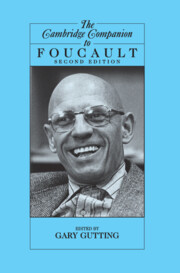Book contents
- Frontmatter
- Introduction Michel Foucault: A User’s Manual
- 1 Foucault’s Mapping of History
- 2 Foucault and the History of Madness
- 3 The Death of Man, or Exhaustion of the Cogito?
- 4 Power/Knowledge
- 5 Ethics as Ascetics: Foucault, the History of Ethics, and Ancient Thought
- 6 Michel Foucault’s Ethical Imagination
- 7 The Analytic of Finitude and the History of Subjectivity
- 8 Foucault’s Encounter with Heidegger and Nietzsche
- 9 Foucault and Habermas
- 10 Foucault’s Relation to Phenomenology
- 11 Against Interiority: Foucault’s Struggle with Psychoanalysis
- 12 Foucault’s Modernism
- 13 Queering Foucault and the Subject of Feminism
- Bibliography
- Addendum to Bibliography, 1993–2005
- Index
Introduction Michel Foucault: A User’s Manual
Published online by Cambridge University Press: 28 August 2006
- Frontmatter
- Introduction Michel Foucault: A User’s Manual
- 1 Foucault’s Mapping of History
- 2 Foucault and the History of Madness
- 3 The Death of Man, or Exhaustion of the Cogito?
- 4 Power/Knowledge
- 5 Ethics as Ascetics: Foucault, the History of Ethics, and Ancient Thought
- 6 Michel Foucault’s Ethical Imagination
- 7 The Analytic of Finitude and the History of Subjectivity
- 8 Foucault’s Encounter with Heidegger and Nietzsche
- 9 Foucault and Habermas
- 10 Foucault’s Relation to Phenomenology
- 11 Against Interiority: Foucault’s Struggle with Psychoanalysis
- 12 Foucault’s Modernism
- 13 Queering Foucault and the Subject of Feminism
- Bibliography
- Addendum to Bibliography, 1993–2005
- Index
Summary
AGAINST INTERPRETATION
For all of Foucault's reservations about modernity and authorship, his writings are typical of those of a modernist author in their demand for interpretation. Any writing, of course, requires some interpretation as part of our efforts to evaluate, refine, extend, or appreciate its achievement or to provide special background that readers outside the author's culture or historical period may require. But certain authors - in literature, the twentieth-century modernists are among the best examples - present themselves as so immediately and intrinsically “difficult” as to require special interpretative efforts even for those well equipped to understand them. The Wasteland, Cantos, and Finnegans Wake, for example, require explanation, even for culturally and historically attuned readers, in a way that Paradise Lost, the Essay on Man, and Emma do not. Philosophy, at least since Kant and Hegel, has also provided its share of “intrinsically obscure” writing. Although it may not be easy to formulate the precise difference, it is clear that Wittgenstein, the later Heidegger, and Derrida require a sort of interpretation that Russell, Dewey, and Quine do not.
Foucault’s penchant, particularly prior to Discipline and Punish, for the modernist obscure explains much of the demand for interpretations of his work. But the need to interpret Foucault sits ill with his desire to escape general interpretative categories. More important, as the enterprise of interpretation is usually understood, interpreting Foucault is guaranteed to distort his thought. Interpretation typically means finding a unifying schema through which we can make overall sense of an author’s works.
- Type
- Chapter
- Information
- The Cambridge Companion to Foucault , pp. 1 - 28Publisher: Cambridge University PressPrint publication year: 2005
- 5
- Cited by



